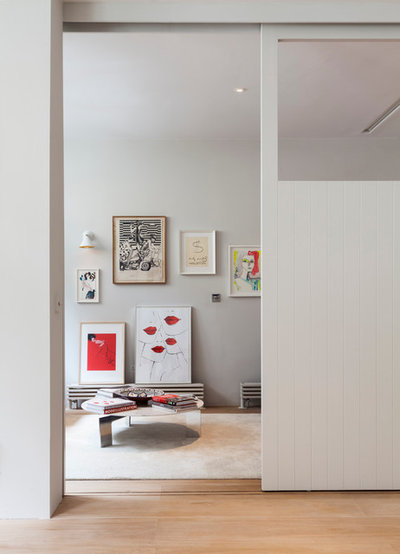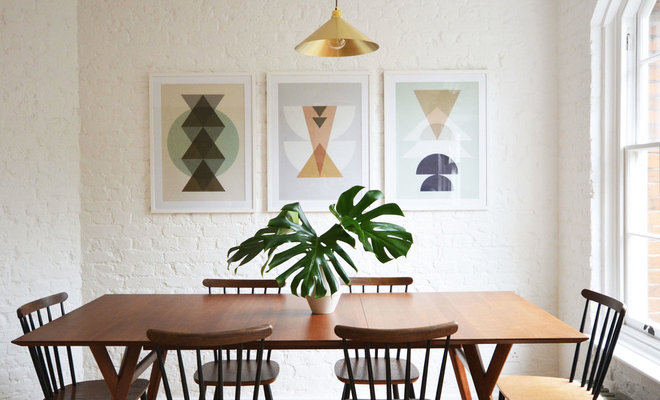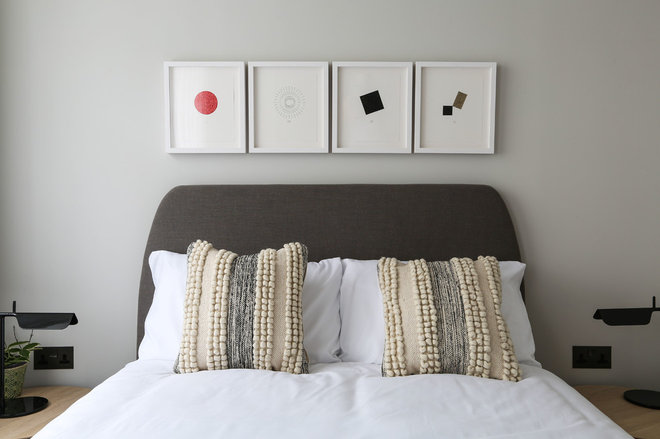When it comes to buying art, you may wonder whether you should choose an original work or go for a limited-edition print. Read on to dispel some myths, understand art world terminology and home in on the art that’s right for you and your space.
Do your research. Whether you’re looking for an original piece or a limited-edition print, it’s worth investing a little time in research before you commit to a purchase. There are countless motivations that move us to buy a piece of art, which is why it’s a good idea to compile a checklist of priorities to make sure the work you find is right for you. Be it the candor of the artist, the sheer beauty of the piece, its collective value or purely its aesthetic, the piece needs to speak to you for all the right reasons.
When your search is complete and you’ve found the artwork you love, check that it’s been signed by the artist — and numbered if it’s a limited-edition print. This guarantees the authenticity of the work.
When your search is complete and you’ve found the artwork you love, check that it’s been signed by the artist — and numbered if it’s a limited-edition print. This guarantees the authenticity of the work.
Original Art
Set your budget. With original art, the clue is in the name: Original pieces are one-of-a-kind. Although it’s a myth that “good art” has to be expensive, it’s true that an original piece may come with a larger price tag than a print. When you’re looking to invest in a piece, set your budget and, if you’re buying at an art fair, negotiate. Maybe you can knock off the cost of delivery or buy in bulk from an artist.
For works bought online or at an exhibition, the price may be a little less flexible. This is where a budget comes in handy, helping you set your sights and narrow your search. If in doubt, make use of rental or try-before-you-buy plans that let you live with the artwork at home before you commit to buying. Although not always the case, size is often a factor in the price of an artwork, so consider the scale you want and what’s going to look best in your space.
Set your budget. With original art, the clue is in the name: Original pieces are one-of-a-kind. Although it’s a myth that “good art” has to be expensive, it’s true that an original piece may come with a larger price tag than a print. When you’re looking to invest in a piece, set your budget and, if you’re buying at an art fair, negotiate. Maybe you can knock off the cost of delivery or buy in bulk from an artist.
For works bought online or at an exhibition, the price may be a little less flexible. This is where a budget comes in handy, helping you set your sights and narrow your search. If in doubt, make use of rental or try-before-you-buy plans that let you live with the artwork at home before you commit to buying. Although not always the case, size is often a factor in the price of an artwork, so consider the scale you want and what’s going to look best in your space.
Preview the work. When you’re making an investment like this, you’re going to want to be sure you’re buying an original piece you’ll love for a lifetime.
Online galleries will offer plenty of plans to help you overcome any inertia, whether it’s shipping the work into a gallery so you can preview it before you purchase or allowing you to rent the work and try it at home for a percentage of the price. Take advantage of these opportunities so you’ll know for sure whether the piece is right for you.
Online galleries will offer plenty of plans to help you overcome any inertia, whether it’s shipping the work into a gallery so you can preview it before you purchase or allowing you to rent the work and try it at home for a percentage of the price. Take advantage of these opportunities so you’ll know for sure whether the piece is right for you.
Support emerging talent. With original art, prices can soar pretty quickly. One way to discover unique, original art that doesn’t break the bank is to seek out emerging artists by attending graduate shows, art fairs and pop-up exhibitions and contacting the artists you love to inquire about their work. Not only will this help you access undiscovered talent, but there’s the potential of the work increasing in value over time — you may end up buying an investment piece without even realizing it!
This statement sculptural work is by one of our artists, Charlotte Jonerheim, a London-based Swedish artist who’s making a name for herself in the contemporary art world. There’s a constant stream of fresh artistic talent to discover, so keep your eye out for new stars.
This statement sculptural work is by one of our artists, Charlotte Jonerheim, a London-based Swedish artist who’s making a name for herself in the contemporary art world. There’s a constant stream of fresh artistic talent to discover, so keep your eye out for new stars.
Search on and offline. The term original art is expansive to say the least, covering the mediums of sculpture, painting, drawing and beyond. We advise looking online and offline in your hunt for works to suit your space and tickle your fancy. Walking around fairs or galleries will give you the opportunity to see works in the flesh, which is especially handy if sculpture or installation art is your thing.
With plenty of online galleries now offering you a glimpse of pieces in situ — be it in a home or at a gallery — you’ll still be able to get a good idea of how a piece might work in your space.
With plenty of online galleries now offering you a glimpse of pieces in situ — be it in a home or at a gallery — you’ll still be able to get a good idea of how a piece might work in your space.
Prints
Consider your medium. Prints come in myriad genres, styles and mediums. Make sure to ask which type of print a work is. Whether it’s an original screen print, a hand-finished print by the artist, a C-type or a giclée print (a high-quality inkjet print), this will indicate how much of the artist’s impression is evident within the work.
It’s also worth checking what type of paper it’s printed on — this will be reflected in the price and can influence how the piece will look when framed. A photograph printed on glossy paper is much more prone to glare and should be kept away from windows, while a matte print on Hahnemhüle paper will absorb the light and have a softer, richer finish. Always check with the artist — they’ll know best and may even be willing to take requests and print to order.
Consider your medium. Prints come in myriad genres, styles and mediums. Make sure to ask which type of print a work is. Whether it’s an original screen print, a hand-finished print by the artist, a C-type or a giclée print (a high-quality inkjet print), this will indicate how much of the artist’s impression is evident within the work.
It’s also worth checking what type of paper it’s printed on — this will be reflected in the price and can influence how the piece will look when framed. A photograph printed on glossy paper is much more prone to glare and should be kept away from windows, while a matte print on Hahnemhüle paper will absorb the light and have a softer, richer finish. Always check with the artist — they’ll know best and may even be willing to take requests and print to order.
Kick-start your collection. For anyone aiming to start their own art collection, investing in prints is a great way to begin. This diverse medium has plenty to offer in terms of sizing, price range and genre. From timeless Pop Art prints to contemporary abstracts, you’re sure to find something you’ll fall in love with.
Online art galleries are especially helpful when it comes to filtering your search. And if you’re still not sure, there should be a curator you can contact to point you in the right direction and answer any questions you might have.
Online art galleries are especially helpful when it comes to filtering your search. And if you’re still not sure, there should be a curator you can contact to point you in the right direction and answer any questions you might have.
Think about the size of the edition. When buying a print, you should always consider the size of the edition. The price of the piece should be reflected in this, depending on the stature of the artist. In theory, a print from an edition of more than 100 should be worth less than one of a smaller edition. Bear this in mind when you’re looking for works, and remember that the lower the edition number, the higher the value.
If it’s the cream of the print world crop you’re after, investing in an artist’s proof is well worth the money. This is a print that the printmaker creates for the artist. It will be marked with “AP” instead of a number.
If it’s the cream of the print world crop you’re after, investing in an artist’s proof is well worth the money. This is a print that the printmaker creates for the artist. It will be marked with “AP” instead of a number.
Try a replica of an original. Investing in a replica print of a favorite original is a great way to get the art you’ve always wanted up on your wall. Whether it’s a piece from a deceased established artist or a contemporary talent that’s out of your budget, this kind of print will set you back a small fraction of the price of the original.
Framed or not. When buying a print, it’s always worth asking whether the work will come already framed. Pre-framed is often an option, which adds an element of convenience.
However, if you’re investing in a limited edition of 100 or you’ve discovered a work from an artist living across the globe, there’s a good chance the work will arrive rolled in a tube. This means you’ll need to decide how you want your piece framed. Consider the mood and furnishings of your room, which will help you choose the frame material and color.
The next choice involves mounting. Whether it’s a window mount to create depth or a float mount to highlight the edge of the piece, there will be a correct mount for any work — simply speak to your framer if you’re unsure.
However, if you’re investing in a limited edition of 100 or you’ve discovered a work from an artist living across the globe, there’s a good chance the work will arrive rolled in a tube. This means you’ll need to decide how you want your piece framed. Consider the mood and furnishings of your room, which will help you choose the frame material and color.
The next choice involves mounting. Whether it’s a window mount to create depth or a float mount to highlight the edge of the piece, there will be a correct mount for any work — simply speak to your framer if you’re unsure.










